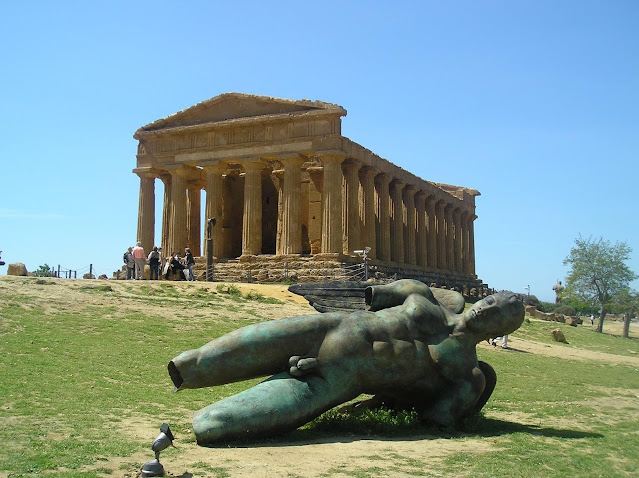Scicli
Sicily is the Italian region with the highest number of
UNESCO World Heritage sites. Ten of these sites can be found in Eastern Sicily,
the list includes; Siracusa, Noto, Ragusa, Caltagirone, Modica, The Necropolis
of Pantalica, The Villa Romana del Casale, Catania, Mount Etna and Scicli.
Off the beaten track, Scicli is a small town located in the province of
Ragusa and is one of the most beautiful in Sicily.
Rebuilt after the earthquake of 1693, Scicli combines open
tree lined piazzas, churchs and baroque palazzos with decorative facades.
The town is surrounded by high rocky cliffs where there is a
castle that protects the town. The city’s origins date back to 1500BC.
Scicli
was dominated by the Arabs and was recaptured in 1091, the year of the Norman
victory over the Saracens.
After the earthquake the town was reconstructed and moved
further south between three valleys.
Being listed as a UNESCO Word Heritage Site, Scicli has
several monuments that are worth visiting, the Church of San Bartolomeo and the
Church of Santa Maria La Nova, the Church of St Ignazio and the Church of Our
Lady of Consolation that still retains its XVII Century door portal. Palazzo
Spadaro, Palazzo Fava and Palazzo Benevantano.
The best place to start your visit is from Piazza Italia and
follow Via Nazionale. Do not miss the side street where the Palazzo Benevantano
sits on a corner, its sculptural decoration is not for the faint hearted. The
carvings underneath the baroque balconies depict the heads of the Arabs after
being be-headed, I have been told that they are truly life like due to the way
the eyes go to the top of the head and the tongue hangs out of the mouth after
execution. A warning never to return.
If you walk up the steps from the palazzo uphill you will
eventually reach The Church of San Mateo which dominates the town, here you will have breath taking views across town. In this area in the cliffs surrounding you there are Neolithic caves which were still being used as dwellings up to
recent times.
The festival of Militia is held at the end of May which
commemorates the Normans victory over the Saracens. There is a
re-enactment of the battle, actors in period costumes and weapons, act out the
highlights of the siege. It is said that the Normans won the battle as the Virgin
Mary descended into the town on horseback encouraging the Norman fighters.
These days Scicli is mostly well known as being the filming
location of the television series Inspector Montalbano. As you walk around town
you expect to see him or one of his deputies around every corner. The town was used as a stand in for the fictional town of Vigata and you will recognise Scicli’s town
hall and the piazza in front. The town hall is the police headquarters in the
series, inside you can visit the chief of police offices which are actually the Mayor
of Scicli’s offices.
Scicli also became famous after a stray dog wandered into
town in 2009, he won the hearts of the town and became a local hero. The dog
named by locals ‘Italo’ was made an honoury citizen of Scicli and a movie was
made about him last year. Read our last Blog post “Italo Barocco …. The story
of Sicily’s famous dog”.
Scicli makes some of the best biscuits and sweets in the
region of Ragusa especially Cuddureddi, Cassata and Pancakes.
We hope we have whetted your appetite to visit Scicli … why
not combine with a visit to Ragusa, Noto and Modica. There are many wonderful
places to explore in Eastern Sicily so keep posted for more Sicilian holiday
inspiration.
If you enjoyed reading this you will love our post “The
Inspector Montalbano Filming Locations Tour”, search my Blog archive.
Scicli Gallery
... with my super duper guide Christy
Thank you for following me at White Almond Sicily
For NEW Blog updates and all things Sicilian
follow me on
Facebook at www.facebook.com/whitealmondprivatesicily/
Twitter www.twitter.com/sicilyconcierge/
Instagram www.instagram.com/whitealmondsicily/
Facebook at www.facebook.com/whitealmondprivatesicily/
Twitter www.twitter.com/sicilyconcierge/
Instagram www.instagram.com/whitealmondsicily/
I am also a contributor to www.timesofsicily.com
Email me at WhiteAlmondSicily@Gmail.Com





















